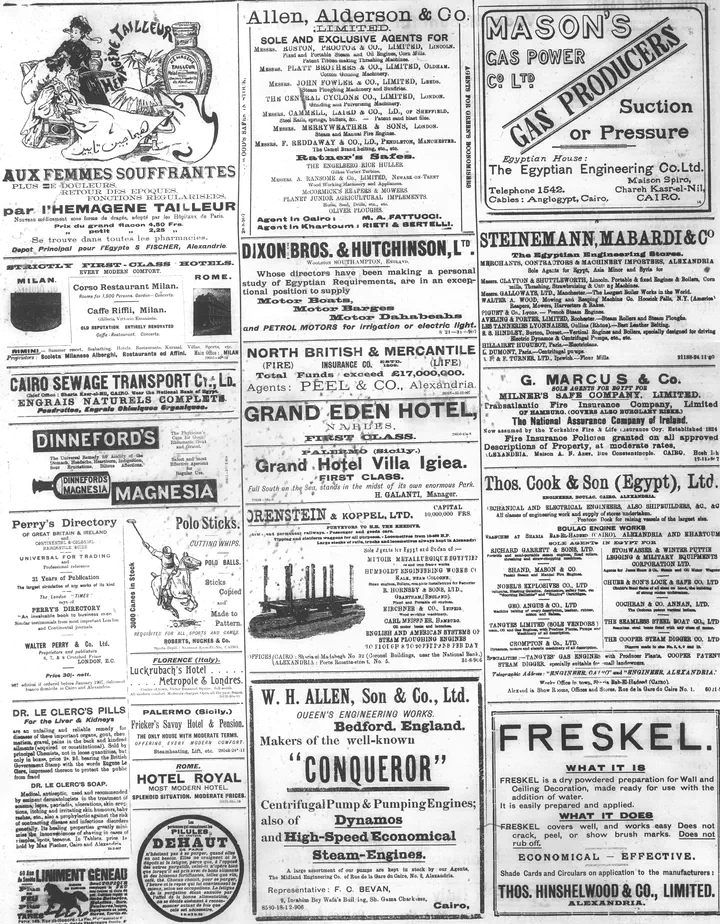Advertising... Has anything really changed?
 Page eight advertisements from the January 28th, 1907 issue of The Egyptian Gazette
Page eight advertisements from the January 28th, 1907 issue of The Egyptian GazetteI happen to really enjoy encoding “The Egyptian Gazette.” It is almost therapeutic. As I venture into another day of my week in January of 1907, I have become accustomed with its format, easily pulling code from other parts of the paper I, and my classmates, have already worked on.
My favorite part of the paper is the advertisement section. No hassle of OCR, lots of pictures, and its sheer simplicity makes me feel like an encoding wiz. And when I was working on my Thursday issue, I imagined myself reading “The Egyptian Gazette” in Alexandria.
This was surprisingly simple for me, to read the newspaper as if I always had, as I even began to memorize the advertisements in the same way people living in Alexandria probably did, knowing their location and contents by heart. Interestingly enough, the most common advertisements seemed to be for travel, focused on both steamship movements and hotels. However, I did not really enjoy reading these advertisements, and even worse were the ones relating to finance or insurance. My favorite by far were the advertisements related to health. These advertisements were less common, but they were unique, scattered throughout the paper making me feel as if I was on a scavenger hunt in search of the next one. They are the complete opposite of the steamship and hotel advertisements that overwhelm the first, second, and last page of the paper. I actually wanted to read the health advertisements because who isn’t intrigued by the idea of something that can make one feel or look better?
Each and every time I see an advertisement for Peruna, a medicine advertised for women, the miracle stories about how it has changed people’s lives, as well its format and illustrations, catch my attention. Peruna’s advertisements jump off the page, unlike the steamer and hotel advertisements whose contents are seemingly stagnant and are not eye-catching at all. The Mena House Hotel advertisement is an example of their lackluster design, with its only description being that it is a “First Class Family Hotel.” Hard to say if I would stay there. The same goes for the boring advertisement for the Savoy Palace Hotel, which does not get me excited at all for it to open “shortly.”
How different are these advertisement tactics from that of today? Not very; the same tactics are used, especially when advertising medicine, as “success” stories continue to be attached to medicines sold in present day. Yet, in terms of travel, it is easier for hotels to excite the consumer today with vivid websites that show luxurious amenities at the click of a button.
Thus, although their contents may have shifted, people are still consumed with products that provide personal benefit, and travel, because even now commercials, computer and phone advertisements everywhere consist of these things, similarly to that of Egypt in 1907. In Alexandria it seems that just like in 2018, trying to get the daily news comes with an unexpected bombardment of advertisements that we love to hate, but hate to love.
If you wish to look more into advertising and its impact in present day with technology and print, check out these links below:
This article talks about how advertising is changing to target the consumer, which is interesting because specific advertisements from “The Egyptian Gazette” were of interest to me, and are probably of interest to you, a concept this article explores.
This article focuses on the idea that print advertisement is in fact not dead, but actually extremely effective because our brains work in such a way that makes us better at memorizing print advertisements over digital ones. In terms of “The Egyptian Gazette” this article highlights the effectiveness of the advertisement section to those who read the newspaper in Alexandria and how it could have bolstered consumer activity.
This article analyzes the changes in advertising ten years after the release of the iPhone. When looking at the advertisements in “The Egyptian Gazette” in comparison to the advertisements that we interact with in the present day, this article dissects this transition from them to now.